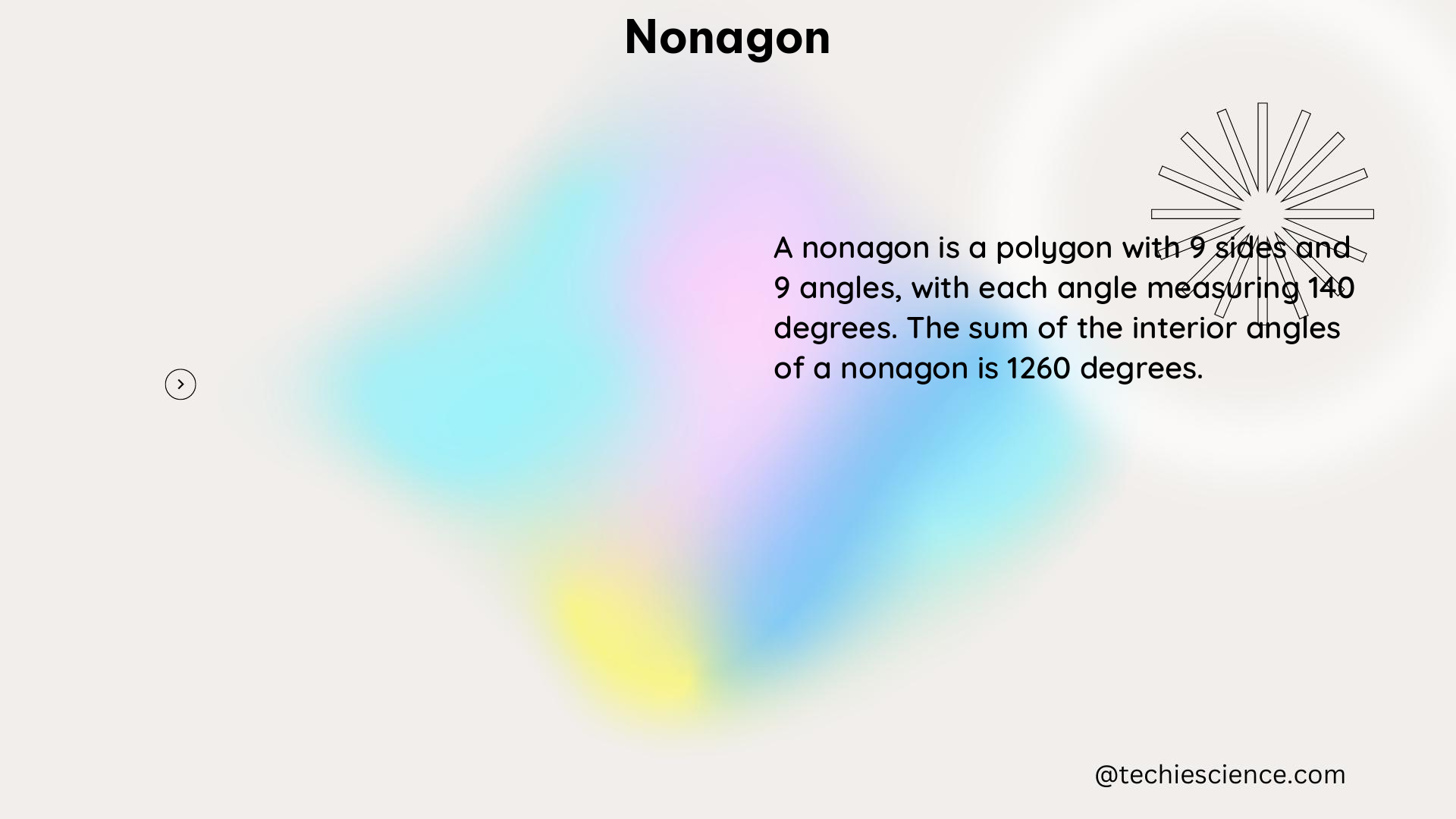A nonagon is a nine-sided polygon with a unique set of geometric properties and practical applications. This comprehensive guide delves into the intricate details of nonagons, providing a wealth of technical information and quantifiable data to equip science students with a deep understanding of this fascinating shape.
Understanding the Basics of Nonagons
A nonagon is a polygon with nine sides and nine interior angles. The sum of the interior angles of a nonagon is 1260 degrees, with each individual angle measuring 140 degrees in a regular nonagon. The sum of the exterior angles of a nonagon, regardless of whether it is regular or irregular, is always 360 degrees.
Nonagon Geometry and Measurements
To fully comprehend the technical specifications of a nonagon, we need to explore its key geometric properties:
- Side Length: The length of each side in a regular nonagon is equal, and this length can be determined based on the desired size of the nonagon.
- Radius: The radius of a regular nonagon is the distance from the center of the polygon to any of its vertices. This measurement is crucial for constructing and understanding the overall structure of the nonagon.
- Apothem: The apothem of a regular nonagon is the perpendicular distance from the center of the polygon to the midpoint of any of its sides. This value is essential for calculating the area of a nonagon.
Nonagon Theorems and Formulas
To delve deeper into the mathematical aspects of nonagons, we can explore the following theorems and formulas:
- Nonagon Interior Angle Theorem: The sum of the interior angles of a nonagon is 1260 degrees, and each interior angle of a regular nonagon measures 140 degrees.
- Nonagon Exterior Angle Theorem: The sum of the exterior angles of a nonagon is always 360 degrees, regardless of whether the nonagon is regular or irregular.
- Nonagon Area Formula: The area of a regular nonagon can be calculated using the formula:
Area = (3√3 × s^2) / 2, wheresis the length of each side. - Nonagon Perimeter Formula: The perimeter of a regular nonagon can be calculated by multiplying the length of one side by the number of sides, which is 9.
Constructing a Nonagon: DIY Techniques

Creating a nonagon from scratch can be a rewarding and educational experience for science students. Here are the steps to construct a nonagon using various materials:
- Materials: Cardboard, paper, wood, or any other suitable material can be used to create a nonagon.
- Measurements: Determine the desired size of the nonagon and measure the length of each side accordingly. Use a ruler or a protractor to ensure accurate measurements.
- Cutting: Cut out nine equal-length sides to form the nonagon shape.
- Assembly: Carefully arrange the nine sides and secure them together to create the final nonagon structure.
- Verification: Use a protractor to measure the interior and exterior angles of the constructed nonagon to ensure it meets the geometric requirements.
Nonagon Applications and Examples
Nonagons have a wide range of applications in various fields of science and engineering. Here are some examples:
- Architecture: Nonagonal shapes are sometimes used in the design of buildings, roofs, and other architectural structures.
- Engineering: Nonagonal shapes can be found in the design of certain mechanical components, such as gear systems and bearings.
- Chemistry: Nonagonal arrangements can be observed in the molecular structures of certain organic compounds.
- Biology: Nonagonal patterns can be seen in the natural world, such as in the structure of some insect eyes or the arrangement of certain plant cells.
Nonagon Numerical Problems and Exercises
To reinforce the understanding of nonagons, let’s explore some numerical problems and exercises:
- Nonagon Side Length Calculation: If the radius of a regular nonagon is 10 cm, calculate the length of each side.
- Nonagon Area Calculation: Find the area of a regular nonagon with a side length of 8 cm.
- Nonagon Perimeter Calculation: Calculate the perimeter of a regular nonagon with a side length of 6 inches.
- Nonagon Angle Measurement: Measure the interior and exterior angles of an irregular nonagon using a protractor.
By working through these problems, science students can deepen their understanding of the mathematical and geometric properties of nonagons, as well as their practical applications.
Conclusion
The nonagon is a fascinating and versatile geometric shape with a wealth of technical details and practical applications. This comprehensive guide has provided a detailed exploration of the key aspects of nonagons, including their geometry, theorems, formulas, construction techniques, and real-world examples.
By mastering the concepts and skills presented in this guide, science students can develop a strong foundation in the study of nonagons and apply this knowledge to various fields of science and engineering. Whether you’re designing architectural structures, analyzing molecular structures, or simply exploring the beauty of geometric shapes, this guide will serve as an invaluable resource for your journey.
References
- Quantifying Nonagon Properties
- Measurable and Quantifiable Goals
- Contra Hanson on Medical Effectiveness

The lambdageeks.com Core SME Team is a group of experienced subject matter experts from diverse scientific and technical fields including Physics, Chemistry, Technology,Electronics & Electrical Engineering, Automotive, Mechanical Engineering. Our team collaborates to create high-quality, well-researched articles on a wide range of science and technology topics for the lambdageeks.com website.
All Our Senior SME are having more than 7 Years of experience in the respective fields . They are either Working Industry Professionals or assocaited With different Universities. Refer Our Authors Page to get to know About our Core SMEs.